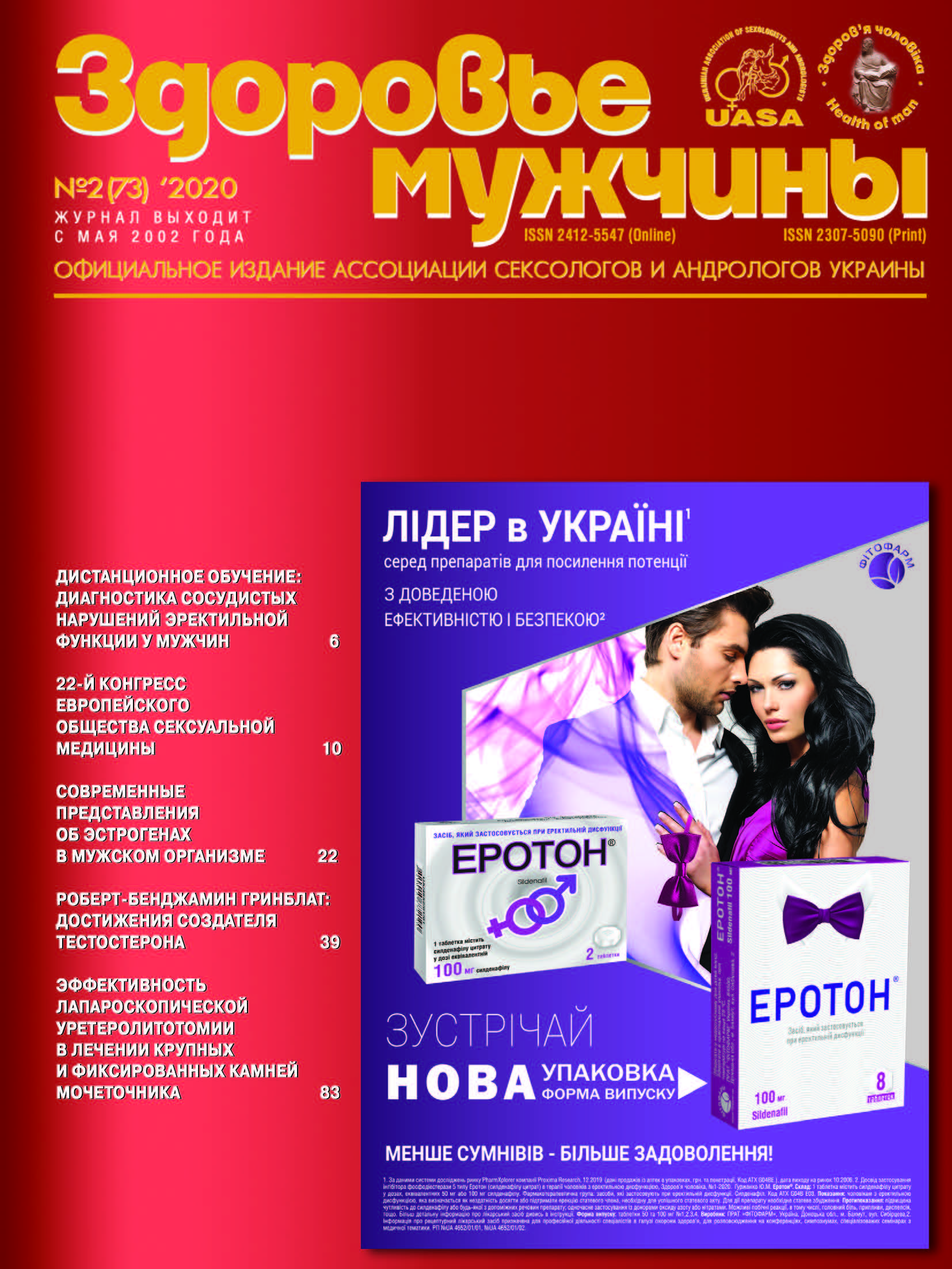Efficacy of Laparoscopic Uretherolithotomy in the Treatment of Large and Fixed Ureteral Stones
##plugins.themes.bootstrap3.article.main##
Abstract
Urolithiasis has been and remains one of the most pressing problems in modern urology. In urological clinics, the number of such patients reaches 20–40 % of the total number of patients. Half of them are patients with ureteral stones. Obstruction of the ureter with stones leads to impaired outflow of urine from the kidney, the accession of obstructive pyelonephritis, the development of ureterohydronephrosis until complete loss of renal function. Removal of large stones, especially those that are in the ureter for a long time, is a serious problem in urology. There are several methods of surgical treatment of ureterolithiasis: extracorporeal shock wave ureterolithotripsy (ESWL), contact ureterolithotripsy (CL), ureterolithoextraction, percutaneous nephrolithotripsy (when moving a stone from the ureter to the kidney). An alternative to these methods is laparoscopic ureterolithotomy.
The objective: to evaluate the effectiveness of laparoscopic ureterolithotomy in the treatment of large and fixed ureteral stones.
Materials and methods. We performed 43 laparoscopic ureterolithotomies in the clinic of theInstitute ofUrology of the National Academy of Medical Sciences ofUkraine for the period from 2014 to 2019. The size of the stones ranged from 15 to25 mm. In 32 (74.4 %) patients the stones were localized in the upper third of the ureter, in 11 (25.6 %) – in the middle third. The stones were in the ureter from two months to two years. In 11 patients the stones were recurrent. In 41 (95 %) on the side of the calculus developed ureterohydronephrosis. 8 patients underwent ESWL before admission to the clinic, three – CL, which were ineffective. In 32 (74.4 %) patients laparoscopic ureterolithotomy was performed as a primary treatment.
Results. As the results of the operation showed, the stones in all patients were completely removed. There were no conversions or intraoperative complications. Postoperative bed-day was from 3 to 5 days. 1.5 months after surgery, renal function was completely restored in all patients, ureterohydronephrosis and recurrence of stone formation were not detected.
Conclusion. Mild traumatisation of laparoscopic ureterolithotomy, the possibility of one-time complete removal of stones, smooth postoperative course, make this method first choice for the presence of large stones and stones that are long in the ureter, as well as ineffective ESWL, CL and others.##plugins.themes.bootstrap3.article.details##

This work is licensed under a Creative Commons Attribution 4.0 International License.
Authors retain the copyright and grant the journal the first publication of original scientific articles under the Creative Commons Attribution 4.0 International License, which allows others to distribute work with acknowledgment of authorship and first publication in this journal.
References
Аляев Ю.Г., Глыбочко П.В., Пушкарь Д.Ю. (2016). Урология. Российские клинические рекомендации. М.: ГЭОТАР- Медиа. 496 с.
Scales S.D., Smith A.C., Hanley J.M., Saigal C.S., (2012). Prevalence of kidney stones in the United States. Eur. Urol. 62(1): 160–165. doi: 10.1016/j.eururo.2012.03.052.
Türk C., Petrik A., Sarica K., Skolarikos A., Straub M., Seitz C. (2016). EAU Guidelines on Urolithiasis. European Association of Urology.
Shoag J., Tasian G.E., Goldfarb D.S., Eisner B.H. (2015). The new epidemiology of nephrolithiasis. Adv Chronic Kidney Dis. 22(4):273–278.
Аль-Шукри С.Х., Антонов А.В., Авазханов Ж.П. (2013). Выбор метода лечения крупных камней верхних отделов мочеточников. Нефрология, т. 17, 4:95–99.
Hruza M., Zuaru J.R., Goeren A.C. (2010). Laparoscopic and open stone surgery. Arch Ital Urol Androl. 82(1):64–71.
Кисляков Д.А., Сирота Е.С., Шпоть Е.В., Еникеев М.Э. (2014). Выбор метода дренирования мочевых путей при лапароскопической уретеролитотомии. Урология,6:88–90.
Мартов А.Г., Теодорович О.В., Галямов Э.А., Луцевич О.Э., Забродина Н.Б., Гордиенко А.Ю., Пархонин Д.И. (2011). Эндоскопическая уретеролитотомия при крупных камнях верхней трети мочеточника. Урология. 5:50–54.
Raboy A., Ferzli G., Joffreda R., Albert P. (1992). Laparoscopic ureterolithotomy. Urology. 39(3):223–225.
Yasui T., Okada A., Hamamoto S., Taguchi K., Ando R. (2013). Efficacy of retroperitoneal laparoscopic ureterolithotomy for the treatment of large proximal ureteric stones and its impact on renal function. Springerplus. 2:600–604.
Khalil M., Omar R., Abdel-Baky S., Mohey A., Sebaey A. (2015). Laparoscopic ureterolithotomy; which is better: Transperitoneal or retroperitoneal approach? Turk J Urol. 41(4):185–190.
Nasseh H., Pourreza F., Kazemnejad Leyli E., Zohari Nobijari T., Baghani Aval H. (2013). Laparoscopic transperitoneal ureterolithotomy: a single-center experience. J Laparoendosc Adv Surg Tech A. 23(6):495–499.
Bayar G., Tanriverdi O., Taskiran M., Sariogullari U. (2014). Comparison of laparoscopic and open ureterolithotomy in impacted and very large ureteral stones. Urol J. 11(2):1423–1428.
Şahin S., Aras B., Ekşi M., Şener N., Tugču V. (2016).Laparoscopic Ureterolithotomy. JSLS. 20(1).





